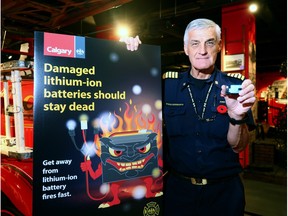What is a lithium-ion battery and why do some catch fire? Here’s a closer look at the batteries powering EVs, electric scooters and more

The number of rechargeable lithium-ion batteries being used in electric vehicles, electric scooters, laptops, powertools and phones is soaring in Canada as demand for those products grow.
Recommended Videos
Here is what to know about these batteries and the risks involved:
What are they?
A lithium-ion battery is a powerful energy storage device that can be recharged by plugging into a standard 120 volt power outlet.
With a lithium-ion battery, the lithium ions are suspended in an electrolyte solution and move back and forth between electrodes as the battery is used or is charged. This electrolyte solution is flammable and, if it gets too hot and the casing cracks, then it will cause a fire.
The smoke produced is also toxic and the fires are difficult to extinguish.
Are battery fires being tracked?
Yes. The B.C. Office of the Fire Commissioner’s 2023 annual report stated rechargeable batteries were the source of 70 fires provincewide.
This was the first year that the B.C. Public Safety Ministry added a new reporting code for fires related to rechargeable batteries.
The 2023 battery fires led to $3.4 million in damages and four injuries, but no deaths.
What does Vancouver Fire and Rescue Services say
The Vancouver Fire Department has been tracking rechargeable battery fires since 2016 when there were six reported. In 2017 there were nine, 2018 there were eight, 2019 there were 11, 2020 there were 22, 2021 there were 29, 2022 there were 38, and 2023 there were 49.
In total, during that time, there have been 16 injuries due to rechargeable battery fires and five deaths. All those deaths occurred in 2022 and three of them were related to one incident with a cellphone battery.
Spokesman Matthew Trudeau says most explosions in Vancouver are happening as a result of e-bike, laptop, vacuum, tablet and cellphone owners not following manufacturer’s directions or recommended best practices for battery charging.
What about electric-car battery fires
Electric-battery car fires are significantly less frequent than e-bike battery fires but do occur. And, when they do, the fires can be difficult to extinguish.
This means an electric fire can be catastrophic on ferries, which has led to B.C. Ferries providing specialized training for EV fires.
Passengers aren’t allowed to travel on ferries with damaged batteries.
“Our team monitors safety recommendations from automobile manufacturers and appropriate authorities to keep our practices up-to-date and our vessels safe,” a B.C. Ferries spokesperson said.
“As this technology evolves, we are continuously reviewing and updating our firefighting policies and procedures to stay aligned with the latest regulations and best practices within the marine industry.”
How to prevent a rechargeable battery fire
The Calgary Fire Department launched a lithium-ion battery fire prevention program last month.
It suggests using only certified lithium-ion batteries, chargers and cords that have been tested in national laboratories (look for a ULC or CSA label on products).
Don’t use batteries that are hot or punctured. Don’t leave batteries charging overnight and don’t let them sit anywhere that is freezing or over 40 C.
Recharge you battery before it dies.